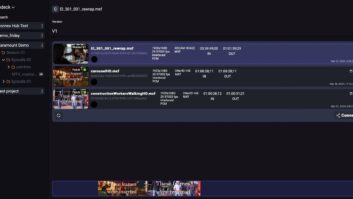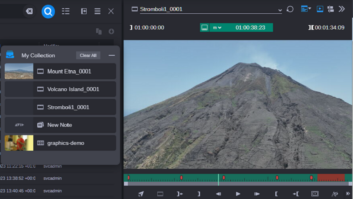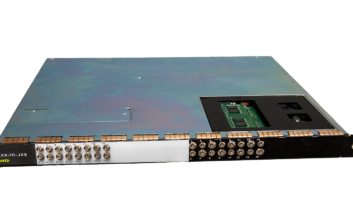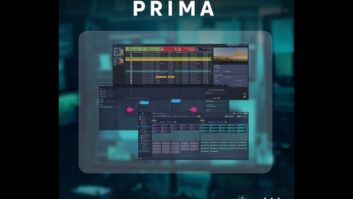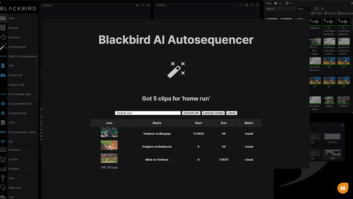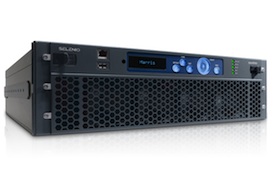
Harris has launched Selenio, a product which combines traditional baseband video and audio processing, video and audio compression and IP networking technology into what the company describes as the broadcast industry’s first integrated media convergence platform.
Selenio is billed as flexible and modular – making it suitable for any fixed or mobile production environment, broadcast facility or digital terrestrial redistribution head end (DVB-T/T2, ATSC, M/H, ISDB-T), as well as cable, satellite and IPTV head ends. Based on proven Harris compression, networking and processing technology, Selenio provides a space-saving, energy-efficient solution that enables service providers to support content from multiple sources and deliver it over multiple platforms.
Operational benefits of the Selenio media convergence platform include intelligent, efficient management of both IP, compressed and baseband signals, reduced control complexity, simple deployment and increased functionality in a smaller footprint. The unique, high-density, modular architecture lowers total cost of ownership by reducing installation, maintenance and upgrade costs.
“Selenio fits into customers’ existing architectures and provides all the functionality they need to run their business most efficiently today, while also providing a cost-effective on-ramp to the IP world as their business evolves,” said Harris Morris, president of Harris Broadcast Communications. “The convergence of baseband and IP capability into a single platform enables customers to quickly add revenue-generating services — from standard definition, high definition and 3D, to mobile and internet broadcasting — without requiring an expensive investment in new infrastructure.”
Selenio enables full-featured, multichannel video and audio processing, distribution and compression applications at a size and density scale unprecedented in the marketplace. Hybrid applications such as decoding an incoming compressed, contribution-quality stream, converting it to the required HD format and re-encoding it for consumer redistribution are easily managed.
The Selenio architecture is designed to maximise operational efficiency. MPEG-2 and H.264 compression standards are supported from SD and HD to 3Gbps and mobile. Virtually any advanced audio capability — including best-in-class loudness control — can be mixed and matched on a single module. A built-in, highly intuitive, graphically rich web-based interface using Microsoft Silverlight technology enables operators to easily configure, monitor and manage the platform’s advanced capabilities.
The unit is currently making its debut at CABSAT and will, of course, be a major part of Harris’ NAB presentations too.
Harris has launched Selenio, a product which combines traditional baseband video and audio processing, video and audio compression and IP networking technology into what the company describes as the broadcast industry’s first integrated media convergence platform.
Selenio is billed as flexible and modular – making it suitable for any fixed or mobile production environment, broadcast facility or digital terrestrial redistribution head end (DVB-T/T2, ATSC, M/H, ISDB-T), as well as cable, satellite and IPTV head ends. Based on proven Harris compression, networking and processing technology, Selenio provides a space-saving, energy-efficient solution that enables service providers to support content from multiple sources and deliver it over multiple platforms.
Operational benefits of the Selenio media convergence platform include intelligent, efficient management of both IP, compressed and baseband signals, reduced control complexity, simple deployment and increased functionality in a smaller footprint. The unique, high-density, modular architecture lowers total cost of ownership by reducing installation, maintenance and upgrade costs.
“Selenio fits into customers’ existing architectures and provides all the functionality they need to run their business most efficiently today, while also providing a cost-effective on-ramp to the IP world as their business evolves,” said Harris Morris, president of Harris Broadcast Communications. “The convergence of baseband and IP capability into a single platform enables customers to quickly add revenue-generating services — from standard definition, high definition and 3D, to mobile and internet broadcasting — without requiring an expensive investment in new infrastructure.”
Selenio enables full-featured, multichannel video and audio processing, distribution and compression applications at a size and density scale unprecedented in the marketplace. Hybrid applications such as decoding an incoming compressed, contribution-quality stream, converting it to the required HD format and re-encoding it for consumer redistribution are easily managed.
The Selenio architecture is designed to maximise operational efficiency. MPEG-2 and H.264 compression standards are supported from SD and HD to 3Gbps and mobile. Virtually any advanced audio capability — including best-in-class loudness control — can be mixed and matched on a single module. A built-in, highly intuitive, graphically rich web-based interface using Microsoft Silverlight technology enables operators to easily configure, monitor and manage the platform’s advanced capabilities.
The unit is currently making its debut at CABSAT and will, of course, be a major part of Harris’ NAB presentations too.
